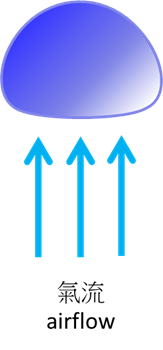The shape of raindrops
The shape of raindrops
Jeffrey LEE Chi-wai
December 2019
What do raindrops look like? Probably 💧 After all, emoji cannot get it wrong, isn't it?
Raindrop falls due to gravity. Falling raindrop, however, does not take that shape due to the physical property of surface tension. This is because water molecules like to stick with each other and minimize the surface area of the water body. A sphere has the smallest surface area for a given volume. Thus, small raindrops (with diameter < 2 mm) are usually spherical in shape, as shown in the light rain icon used by the Observatory (Figure 1).
How about larger raindrops (with diameter of 3-6 mm)? In addition to surface tension, the shape of larger raindrops is affected by deformation by airflow. As a large raindrop falls through the sky, air flows around the raindrop, causing pressure to its bottom slightly higher than that to its top. Its bottom hence gets flattened out, making it look like a custard bun. The effect of airflow is smaller on small raindrops as smaller raindrop falls slower.
How about even larger raindrops? It turns out that as raindrops grow beyond a certain size, they will become aerodynamically unstable and break into smaller raindrops when they fall.
The shape of the raindrop affects the appearance of the rainbow. It will be further discussed in the near future.
Figure 1 Light rain icon used by the Observatory showing spherical shaped small raindrops.

Figure 2 Shape of larger raindrops. The spherical shape of raindrop is deformed by the airflow around it, flattening its bottom.